Micah Z. Brodsky
PhD (MIT, 2014)
Extracurricular excursions
I dabble in amateur radio (KB1WNL) and have a penchant for repairing electronic test equipment. (Trophy roster includes two oscilloscopes, three function generators, and at least three benchtop power supplies.) I refuse to occupy an office lacking soldering iron and oscilloscope!
The Beach 40 is a fun little radio to build — a 7MHz DSB transceiver with only 8 transistors. I made some important modifications, though, as the original schematic has some serious issues with the receive AF amp. (Will post those sometime.)
I built a LEGO driven pendulum as a demo while TAing Gerry Sussman &
Jack Wisdom's classical mechanics class. The pendulum is driven
approximately vertically by a Watt linkage. It has an unfortunate amount
of friction (despite lubricant), and so steady state chaos is hard to
generate, but you can easily produce chaotic transients and multiple
whirling and oscillating modes.
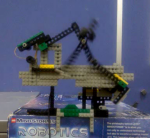
(video here)
Frost grows in interesting patterns under high electric fields.
(~20kV homebrew flyback converter, terminals in a box of dry ice
pellets)
When I'm trying to understand a new mathematical or physical concept, I often build a simulator. (Unless Paul Falstad already has one — despite the decline of Java applets, his are awesome.) I probably spent more time playing with simulators than doing my homework in undergrad physics. Most of my simulations are not polished into a shareable form, but here are two exceptions, back from when Silverlight was cool:
- Silverlight Kaleidoscope – a kaleidoscope simulator I wrote in Silverlight / C#
- Ripple simulator – a raindrop ripples effect, based on a Silverlight sample from nokola.com, but rewritten with more physically accurate mechanics using a hexagonal waveguide mesh with dispersion compensation
The Swift-Hohenberg equation is one of my favorite old toys, an "amplitude equation" capturing the low-order pattern forming phenomena in a variety of systems. It was originally derived in reference to convection in fluid films but is also a great model for Turing-type patterns. It cleanly illustrates a lot of important phenomena — instabilities, boundary effects, the role of even-order nonlinearities in favoring spots over stripes, the impacts of gain and bandwidth (compare images below)...
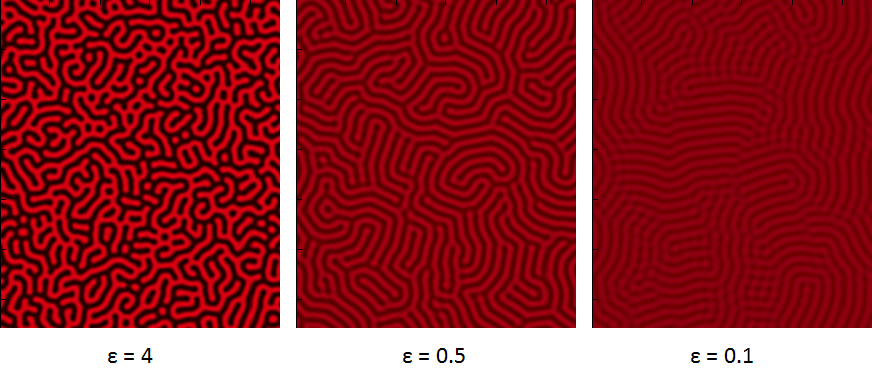
(ε is the linear gain parameter, which Wikipedia calls r)
Some years ago I built a parallelized, aggressively optimized FDTD simulator with MPI to do real-time experiments with the Swift-Hohenberg equation (originally targeted to a SiCortex 648-processor mini-supercomputer — talk about overkill!). Nowadays, my 12-core workstation is fast enough to run it. Some fun videos:
- Islands in biased initial conditions evolving into stripes (ε = 3.0)
- Spots in biased initial conditions (and stripes, from the region boundary) that give way to stripes because system is inversion-symmetric (ε = 1.5)
- Stripes in unbiased initial conditions retracting into islands due to a quadratic nonlinearity (ε = g2 = 1.5)
- A boundary instability! (ε = 3.0; ε = 2.0) The positive (red) and negative (blue) steady states here are both stable — but an interface between them is not!
Faraday resonance is a fun pattern-forming phenomenon in fluids: when a fluid layer is oscillated vertically with sufficient amplitude, standing waves spontaneously appear. It's a form of parametric resonance: unlike the classical driven resonance that you learn about in DiffEQs, it's induced by periodic modulation of the coefficients, requiring finite drive amplitude and leading to both harmonic and sub-harmonic excitation. The first sub-harmonic is typically the strongest excited mode; think of holding a pendulum by the pivot and giving an upward tug every time it begins to return toward equilibrium.
Sub-harmonic excitation has an interesting consequence: only
odd-order nonlinear interactions are resonant. Thus, the usual mechanism
giving rise to hexagonal lattices of spots is unavailable. Instead, one
tends to see rolls, chaotic evolution, or square lattices. Some
examples — detergent-water mixtures oscillated vertically on a speaker
cone (excitation ~60-100Hz):
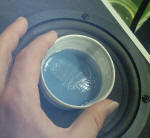
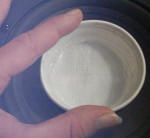
I like to garden from seed — a fascinating (and humbling) hands-on
exercise in complex systems. Even in a 3rd-floor apartment.
This 2nd
generation sunflower seems to have picked up a multi-head trait
(axillary blooms) from around the neighborhood:
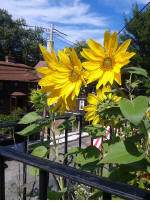
Thought avascular land plants besides mosses and algae were relegated
to the dustbins of evolutionary history? Think again! This lovely crop
of liverwort grows right on MIT's Stata Center building:
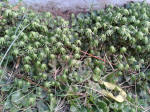
I dabble in microscopy with my old Nikon Model S. Someday I will build a camera mount and post some pictures. That day is not today.
